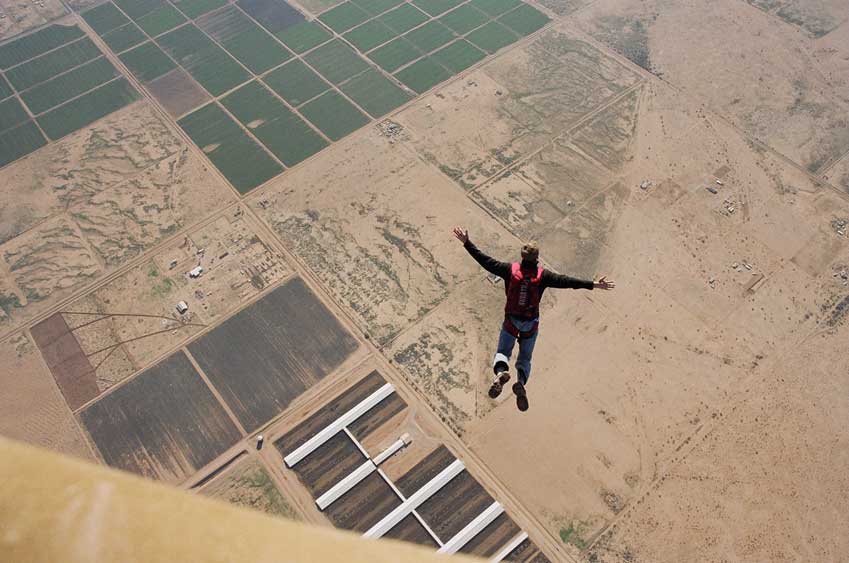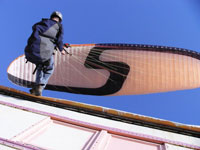Collapsible Truth (Article #18)
By: Bill Heaner
Copyright 2008
Paragliding deflations have become a big topic of discussion on internet forums. I think it is useful to offer some perspective on this wildly misunderstood topic.
It’s my opinion that the goal of internet based discussions should not be for instruction…especially when it comes to topics like catastrophic deflations near the ground. Please understand that when those of us who teach this stuff see it battled out on the internet, we usually stay away. I was kindly asked if I would offer my perspective…here it is without really telling you how or how not to do something. For that you will have to come to us and do it over the water under instruction.
Internet discussions get tricky because the variables of the discussion are rarely, if ever, flushed out properly and, maybe more importantly, the perspective needed by those interpreting the topic is not complete. Inevitably though, difficult forum type discussions pop up from time to time without the proper context and, to an extent, take place in reverse. This is one of them.
First of all…
Believe it or not, there are ways to not take random, major deflations, but you have to be down with really understanding what causes them…the sad reality, is that many, many pilots do not get the proper instruction or continuing education and will experience problem deflations for all the wrong reasons…most all are preventable and many times the results are tragic.
Things that go bump in the day that should make you worry:
- Flying through mechanical turbulence from buildings, trees, mountains, other gliders, etc.
- Flying in natural turbulence, i.e. unstable conditions outside of your skills and experience (gusty winds, thermic)
- Radical, pilot induced symmetric and asymmetric angle of attack changes (e.g. motor induced, towing without proper instruction or with an inexperienced tow operator or those practicing maneuvers without proper instruction)
- Flying the wrong equipment for your skills, ability and experience – not understanding paraglider speed systems and using them at the wrong time, in the wrong way or for the wrong reasons
- Not having a firm grasp of adequate and appropriate brake pressure during every moment of your flight.
So now, you know my opinion that talking about what to do in a catastrophic deflation on an internet forum is the wrong conversation. Talking about why they happen, how to avoid them and finally how to prepare for said deflations is where all of the really good educators in our sport go. All this BEFORE you encounter scenarios that would deliver you major pain and/or expense.
Big Point #1I would say that ANY active pilot that has ANY chance of taking a catastrophic deflation without knowing why or exactly what to do before and after it happens needs an intervention…please call me or anyone on our team so we can sort this out properly together. You will be amazed (after only a few days on the ground and then over the water) at how much you will really understand this topic at a reflexive level. You can even try out all the suggestions you hear about for yourself and truly find out what works the best. Want to throw your reserve? Yea, you can do that too. And yes, they really work.
Don’t fly with a reserve? Start now.
Big Point #2
The only way to thrive and possibly save yourself from injury or death in paragliding is to get into the mind set of attaining “mastery” of your wing and then truly understanding your exposure. This begins with great instruction and a real commitment to persistent and consistent practice on the techniques that improve your mastery. There is no training available that will get you to where you need to be in two or three days. You cannot learn it from watching a video. Accurately understanding and managing risk requires a progressive, phased approach to learning that takes a real commitment, a lot of time and an experienced, great instructor.
Misconception (motor pilots): “I don’t plan on free flight so I don’t need to know about this subject.”
Truth: There is no such thing as free flight or motor flight…get it out of your head. Start talking and thinking about “wing mastery”, then fly with a motor, without a motor, kite, tow, ridge soar, thermal…go for a complete understanding of your wing…really, a complete understanding…no really, a complete understanding. Don’t settle for living in Pleasantville…explore your world. It will make you a SAFER, BETTER, HAPPIER MORE CONFIDENT PILOT – I promise. Not only that, but you will become a resource to those around you instead of a drain.
Big Point #3
Mediocrity plagues our sport. This is a mystery to me. I would understand if you were flipping a coin for a lunch spot, but not aviation.
Accurately and actively understanding and managing risk should be at the top of your list. Mediocrity won’t get you there.
Biggest Point #4
Don’t try out the instruction you read on the internet for things like “how to get out of an 80% collapse at 30 feet from the ground.” Talk about these big ticket items with your qualified instructor. If you don’t get that he/she really understands this stuff well enough then find someone who does. Come see me (not a sales pitch…really) or anyone you can find that does over the water safety training. In addition, also seek out seminars that deal with flying in unstable air, advanced ground handling, etc.
Summary
Keep learning, question everything you read/hear…remember, wing mastery and accurately managing risk and exposure are your goals.
Bill Heaner
www.billheaner.com
bill@billheaner.com
801-541-8341
 Patience and perseverance. The saga continues. We’ve decided to move the balloon stunt to southern California. The weather has become too hot to continue in southern Arizona. We had one attempt at it, but had some technical difficulties with the paramotor aerial photography unit, radios and a bit of unexp...ected thermic turbulence due to a late start in the morning.
Patience and perseverance. The saga continues. We’ve decided to move the balloon stunt to southern California. The weather has become too hot to continue in southern Arizona. We had one attempt at it, but had some technical difficulties with the paramotor aerial photography unit, radios and a bit of unexp...ected thermic turbulence due to a late start in the morning.



